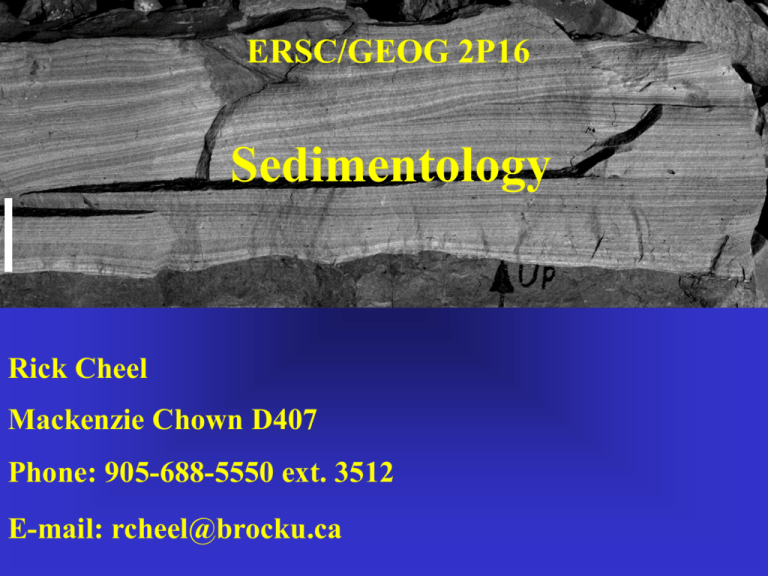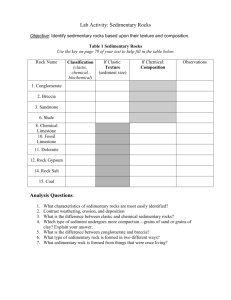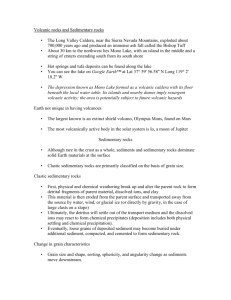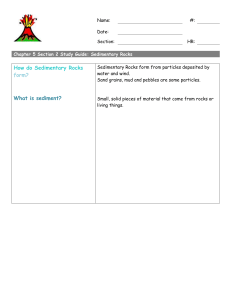Downloadable
advertisement

ERSC/GEOG 2P16 Sedimentology Rick Cheel Mackenzie Chown D407 Phone: 905-688-5550 ext. 3512 E-mail: rcheel@brocku.ca All course material, including the course outline, lecture notes and PowerPoint presentations are available from: http://www.brocku.ca/sedimentology Grade Distribution Assignments 25% Midterm Test 20% Wednesday, Feb. 18, in class Assignment Test 15% March 29, in lab period Final Exam 40% Friday, March 4 is the last date for withdrawal without academic penalty and last day to change from credit to audit status for duration 3 courses. Textbook: Introduction to Clastic Sedimentology Downloadable from: http://spartan.ac.brocku.ca/~rcheel/teaching/sedimentology/SedNotes/ Topics to be covered: 1. Grain Texture (fundamental descriptors of granular material) Grain size Grain shape Porosity and permeability Grain orientation 2. Classification of terrigenous clastic rocks. Arenite Rudite Lutite 3. Unidirectional fluid flow and sediment transport Characteristics of unidirectional flows Simple fluid flow Fluid gravity flows Sediment transport Modes of transport Initiation of transport 4. Bed forms and stratification under unidirectional flows Bed forms Terminology The sequence of bed forms Bed form stability fields Cross-stratification formed by bed forms. Terminology Origin of cross-stratification Cross-stratification and bed forms. 5. Flow, bed forms and stratification under oscillatory and combined flows Characteristics of gravity waves Bed forms and stratification under symmetrically oscillating currents Bed forms and stratification under combined flows The enigma of Hummocky Cross-stratification Assignment Schedule (Winter, 2011) January 11 No assignment January 18 No assignment January 25 1. Analysis of Grain Size Data February 1 Assignment 1 continued February 8 2. Analysis of Grain Shape February 15 3. Analysis of paleocurrent data February 22 Reading Week March 1 4. Classification of clastic rocks March 8 Assignment 4 continued March 15 5. Paleocurrent problems March 22 Hand in assignment 5 March 29 Assignment Test Clastic Sedimentology: The study of sediment and sedimentary rocks that are made up of particles that are the solid products of weathering at or near the Earth’s surface. Gravel Sand Mud (silt and clay) Conglomerate Sandstone Siltstone and Shale Purpose of the course: To introduce terminology and fundamental concepts for the description and interpretation of clastic sediment and sedimentary rocks. Why study clastic sediment? Sedimentary rocks make up only 7.9% of the Earth’s crust. 66% of the surface of the Earth is covered by sediment or sedimentary rocks. Humans interact with the Earth largely at or near its surface. They….. Grow food on it. Build structures on it. Take resources from it. At the same time they….. Hide garbage and other waste material in it. Modify its physical and chemical properties so that it is no longer useable by them. It is important to understand the various properties of the sedimentary cover and have systematic methods for describing these properties. Sedimentary rocks record the history of changing environments on Earth. Based on the recognition of the signature of changing environments over time, as preserved in the rock record. Environmental interpretation of rocks + Age of rocks = Earth History Large scale cross-bedding in 240 million year old rocks in the Central US. = windblown sand dunes; the Central US was a desert at that time. Environmental interpretation: The present is the key to the past. By examining the characteristics of various environments on Earth today we can interpret the environments in which ancient sediments were deposited. Age of rocks: Based on relative age (relative to associated rocks) or absolute age (radiometric dating). Earth History: The history of changing environments on Earth. ERSC/GEOG 2P16 focuses on: The description and classification of clastic sediment. Processes and their products in the sedimentary record that aid in interpreting ancient sedimentary environments.









